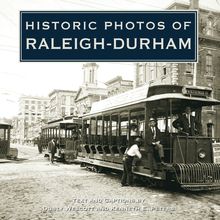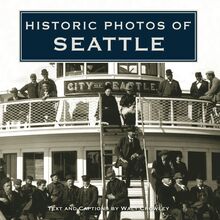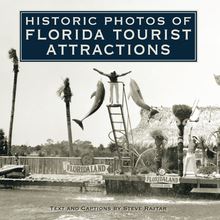Historic Photos of Pensacola , livre ebook
184
pages
English
Ebooks
2008
Vous pourrez modifier la taille du texte de cet ouvrage
Obtenez un accès à la bibliothèque pour le consulter en ligne En savoir plus
Découvre YouScribe en t'inscrivant gratuitement
Découvre YouScribe en t'inscrivant gratuitement
184
pages
English
Ebooks
2008
Vous pourrez modifier la taille du texte de cet ouvrage
Obtenez un accès à la bibliothèque pour le consulter en ligne En savoir plus
Publié par
Date de parution
01 mars 2008
Nombre de lectures
1
EAN13
9781618586674
Langue
English
Poids de l'ouvrage
52 Mo
Pensacola is a city of firsts, from the first documented European settlement in North America to the first Naval Aviation training station. From its earliest incarnation as a town of unpaved streets, through the devastating fire of 1880 to the modern city it would become, this Florida city thrives on challenges.
Historic Photos of Pensacola captures the history of Pensacola from the Civil War through the 1960s in nearly 200 black-and-white archival photographs. Author Jacquelyn Tracy Wilson, a fifth-generation Pensacola native, captures the spirit of Pensacola—from the commonplace to the quintessential—in a century-long journey through this beautiful town.
Publié par
Date de parution
01 mars 2008
Nombre de lectures
1
EAN13
9781618586674
Langue
English
Poids de l'ouvrage
52 Mo
HISTORIC PHOTOS OF
PENSACOLA
T EXT AND C APTIONS BY J ACQUELYN T RACY W ILSON
General Andrew Jackson accepted the transfer of Florida from Spain on July 17, 1821, in Plaza Ferdinand VII. The monument in the center of the plaza is dedicated to William Dudley Chipley, who created and built the Pensacola Atlantic Railroad. City Hall is on the left and the Louisville Nashville Railroad grain elevator, which was destroyed by the 1926 hurricane, is the tall building in the rear.
HISTORIC PHOTOS OF
PENSACOLA
Turner Publishing Company
200 4th Avenue North Suite 950
Nashville, Tennessee 37219
(615) 255-2665
www.turnerpublishing.com
Historic Photos of Pensacola
Copyright 2008 Turner Publishing Company
All rights reserved.
This book or any part thereof may not be reproduced or transmitted in any form or by any means, electronic or mechanical, including photocopying, recording, or by any information storage and retrieval system, without permission in writing from the publisher.
Library of Congress Control Number: 2007941387
ISBN-13: 978-1-59652-426-2
Printed in the United States of America
08 09 10 11 12 13 14 15-0 9 8 7 6 5 4 3 2 1
C ONTENTS
A CKNOWLEDGMENTS
P REFACE
A C ITY OF F IRSTS (1861-1899)
R ESILIENCE AMID H ARDSHIP (1900-1919)
B ETWEEN THE W ARS (1920-1939)
A C HANGING C ITY (1940-1960 S )
N OTES ON THE P HOTOGRAPHS
Margaret Wilkinson, Mary Turner, and Joan Simmons (left to right) pose with a pair of Navy wings and a Blue Angels jet during the Naval Aviation 50th anniversary celebrations at Pensacola in 1961.
A CKNOWLEDGMENTS
This volume, Historic Photos of Pensacola , is the result of the cooperation and efforts of many individuals and organizations. It is with great thanks that we acknowledge the State Archives of Florida for their generous support.
As author, I would like to thank the Pensacola Historical Society for the use of their excellent research materials. Mr. David P. Ogden, historian and ranger for the Gulf Islands National Seashore, was an invaluable source for information about Fort Barrancas and the Navy Yard. Lieutenant Commander Donald T. McCloskey, USN (retired), offered me his vast knowledge of naval aircraft. The information they freely shared with me improved this book immensely.
P REFACE
Others have written wonderful books full of photos of Pensacola s past. I hope that my effort will be accepted for what it is intended to be, an addition to the story of the growth and development of a Southern city with a special place in history. As a native and lifelong resident of the greater Pensacola area, I hope that my personal knowledge and love of Pensacola has helped to add just that little something that may have been overlooked by others.
Photographs help to bring the past to life in a way that words alone cannot accomplish. They help the viewer understand a way of life that is foreign to them. Images capture moments of time, freezing minute details that may be overlooked elsewhere, aspects of the past that would otherwise be lost in the passage of time. Photographs also help cement our connections with the past. As a historian, I believe that we cannot understand the present without knowing the past that has shaped our environment. As an artist, I know that the visual can make a powerful, lasting impact on the viewer. Photographs are a wonderful aid for adding to our knowledge.
With the exception of cropping images where needed and touching up imperfections that have accrued over time, no other changes have been made to this collection of photographs. Their caliber and clarity are limited by the technology of the day and the ability of the photographer at the time they were made.
Pensacola has a long history filled with triumph and with tragedy. The photographs presented here capture some of these moments. The story begins with scenes of Confederate troops defending Fort Barrancas, which was recaptured by Union forces after the Confederate withdrawal from the city. Scenes of the bustling port city are followed by the stark images of a city almost totally destroyed by fire in December 1880. Throughout the book s pages are scenes from everyday life-triumphal parades, disasters, and people at play. And Pensacola s military bases, so important to the city, receive special focus. I hope you will enjoy these photographs and appreciate the full range of emotions many of them can evoke. Gaze amused at some of the dress styles, take pride in the city s accomplishments, understand the pain inflicted by wars. You will have the privilege of watching Pensacola grow and mature as you travel through these pages.
I wish that I could tell a much broader story than the one in this book, because Pensacola has so many stories to offer, but the scope of any single book must always be limited. Much of this book concentrates on the old core of Pensacola, the area found within the confines of Pensacola Bay, North Hill, Florida Blanca Street, and DeVilliers Street. Of course, no history of Pensacola is complete without a look at the Navy bases, the forts, and Pensacola Beach. As I look at old photographs, I want to know the story that was captured when the shutter clicked and the scene was burned onto film. With the use of newspaper clippings, city directories, conversations with knowledgeable people, and information in the archives of the Pensacola Historical Society, I have tried to find some of the stories hidden in these images. I hope you enjoy these stories as much as I do.
Confederate troops occupied Fort Barrancas from January 12, 1861, until they withdrew from Pensacola on May 10, 1862. These cannon overlooked the mouth of Pensacola Bay, controlling access to Pensacola s port. The shot furnace is in the upper-right corner of the photograph.
A C ITY OF F IRSTS
(1861-1899)
Pensacola was the first European settlement established in North America. Don Trist n de Luna y Arrelano arrived with 1,500 soldiers and settlers in 1559. Unfortunately, the settlement suffered after being ravaged by a hurricane and was abandoned two years later. A permanent European settlement was not established in Pensacola until 1698, but by 1861, Pensacola had become the largest city in Florida.
For many people, the beginning of the Civil War is associated with the shots fired at Fort Sumter, South Carolina, on April 12 and 13, 1861. Many historians have downplayed hostilities that took place in Pensacola prior to that date. At 11:00 P.M . on January 8, 1861, Confederate forces, under Colonel William H. Chase, fired upon the Union Army under the command of Lieutenant Adam J. Slemmer at Fort Barrancas, just west of Pensacola. On January 10, Lieutenant Slemmer moved his detail from Fort Barrancas to Fort Pickens on Santa Rosa Island, a position he felt would be easier to defend. The two forts engaged each other on November 22 and 23, 1861, firing 6,000 cannon balls across the mouth of Pensacola Bay. Because the forts sit just beyond the range of the cannons, very little harm was done to either fortification. Confederate troops pulled out of northwest Florida in 1862 and the Union Army regained control of Pensacola on May 10, leaving the forts virtually unscathed by the war. The Navy Yard, however, suffered heavy damage on November 22 and during another engagement on January 1, 1862. Confederate troops destroyed most of the buildings in the Navy Yard before withdrawing from Pensacola.
Pensacola grew around the waterfront. For many years, Pensacola could boast that it was the only natural deep-water port in the United States on the Gulf of Mexico. Fishing boats that harvested the abundance of fish in the local waters competed with cargo ships for dock space. Pensacola became known as the Red Snapper Capital of the world, and special boats, called Snapper Smacks, were devised to keep the deep-water fish alive in the days before ice was manufactured in the city and used to prevent spoilage. Fortunes were made when entrepreneurs realized that this port offered cheap transportation for the lumber they could cut from the dense forests of northwest Florida and southern Alabama. The port also attracted railroads, resulting in multiple lines serving Pensacola and the port.
Pensacola escaped the devastation suffered by many cities during the Civil War. However, an estimated nine-tenths of the city was destroyed on December 11, 1880, when a fire swept through the South Palafox business district. The citizens of Pensacola worked together to rebuild their city and make it better. The city endured extreme weather changes as the end of the century neared. The Great Blizzard of 1889 set record low temperatures and blanketed the city with several inches of snow. Snow covered the city again in 1894 and 1899.
Troops from Alabama, Mississippi, and Louisiana supplemented the Florida forces stationed at Fort Barrancas. The First Alabama Infantry Regiment was primarily responsible for manning the batteries at the fort. Their camp, pictured here, was behind the rear wall of the fort.
The 9th Mississippi was one of the first Confederate regiments to form in that state. They marched into Pensacola in April 1861 and camped near Fort Barrancas.
Along with cannons, Confederate soldiers used mortars to defend Fort Barrancas. Used to lob shells over walls and other obstacles, the mortar s range was controlled by the amount of gunpowder used with the round.
The original mission of ships stationed at the Pensacola Navy Yard was to patrol the Gulf of Mexico and the Caribbean to intercept pirates and slave ships. Some of the cannon used for defense of the yard are displayed in 1865. The steam engineering department, machine shop, and hospital are visible at the rear of the photograph.
These Confederate troops camped beside Bayou Grande may be members of Company A of the Orleans Cadets, the first Confederate volunteer force to form in Louisiana. The Orleans Cadets organized on April 11, 1861, the day after Conf














